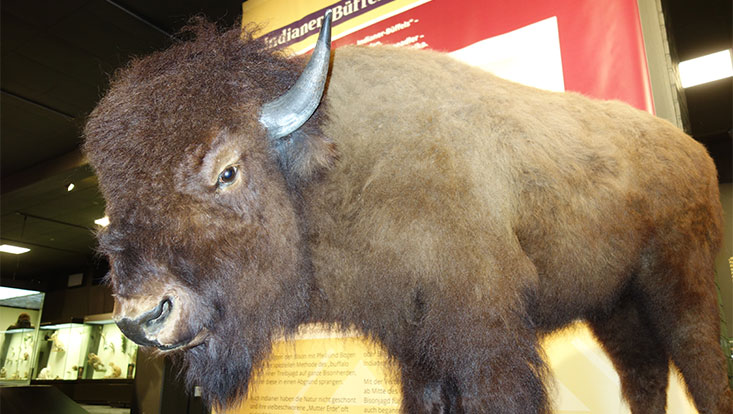
Treasure of the month August: The American Bison
1 August 2018

Photo: UHH/CeNak, Kulmus
For Native Americans, bison were of central importance.
Where today a strait separates the continents, their ancestors migrated during the Ice Age across the land bridge from Siberia to Alaska. They gradually settled in North America in huge herds: bison, the largest land mammals in America today, weighing up to 900 kilograms. They represent vast prairie landscapes -- but also massive human encroachment on the ecosystem. Until the end of September, a bos bison is visiting the Museum of Nature - Zoology as part of the special exhibition "Indians - Lost Worlds." For the native peoples of North America, the "Indian buffalo" were existential.
Originally, the wild cattle known today evolved from the steppe bison in Eurasia. The animals migrated to North America during the Ice Age and initially colonized the northernmost parts of the continent. Two species developed from them, which also conquered the more southern parts in large herds. Today, a distinction is made between prairie bison (B. bison bison), which evolved just about 6,000 years ago, and woodland bison (B. bison athabascae) in forested areas. Giant bison have rather short horns compared to their ancestors. They feed almost exclusively on sweet grasses and sour grasses.
For the native peoples of North America, bison were of central importance as a supplier of meat, leather and fur. In the special exhibition "Indians - Lost Worlds", the bison therefore stands for the life of the Indians on the one hand - and, as a victim of excessive hunting by white settlers, symbolizes the destruction of their habitat and their culture at the same time. At first, the natives even cooperated with the settlers. Bison were then almost completely wiped out from the second half of the 19th century, except for small remnant populations. Of millions of animals, only less than 1,000 specimens remained at the beginning of the 20th century. Particularly perfidious was the hunt by rail: The animals grazing on railroad tracks were shot from the wagons with the shotgun, regular competitions developed.
Today there are again individual, but independent herds on the continent, which are strictly protected. In 2016, then U.S. President Barack Obama issued a decree elevating the bison to the status of the country's second official heraldic animal - alongside the bald eagle. The specimen in the Museum of Nature - Zoology is on loan from the Bremen Overseas Museum. The animal originally lived in a zoo in Helsinki and was then donated to Bremen by the local Natural History Museum. The American bison can be admired in Hamburg until the end of September. Bos bison, as it is scientifically called, is joined by other animals such as bears, horses and wolves from the habitats of the indigenous peoples of North America.
https://www.cenak.uni-hamburg.de/ausstellungen/museum-zoologie/indianer-verlorene-welten.html
